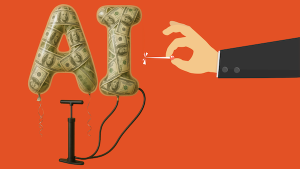Times have changed. Now we have David Brooks, of The New York Times, and economics blogger Noah Smith defending neoliberal globalization from the pincer movement of anti-trade populists from both the right and the left.
It’s good to be old. Old enough to remember when a function of outfits like the American Enterprise Institute was to defend Ronald Reagan and Paul Volcker from critics like me,[1] indeed, to argue that they had saved America from stagflation – and brought “Morning in America” to the people.[2]
In this, the AEI and its allies were aided in later years, it is true, by the American Left. Finding the ideological bulwarks protecting Reagan and Volcker impregnable, the Left focused its ire on the trade deals of the GHW Bush-Bill Clinton era, notably NAFTA. In so doing, it overlooked the fact that offshoring to Mexico had flourished under the maquiladora program since the 1960s, and that the larger effects of NAFTA were to open Mexico’s food and energy sectors, forcing Mexican farmers into the cities and across the northern border – a point more salient today than it seemed back then.
Times have changed. Now we have David Brooks, of The New York Times, and economics blogger Noah Smith, in what appears to be today’s urgent political task, to defend neoliberal globalization from the pincer movement of anti-trade populists, Donald Trump and J.D. Vance, Bernie Sanders and Alexandria Ocasio-Cortez. To do this, Brooks, citing Smith and Michael Strain of AEI, makes a remarkable admission: “wages really did stagnate, but they did so mostly in the 1970s and 1980s, not in the supposed era of neoliberal globalization.” Brooks doesn’t mention that from 1979 to 1987 the Chairman of the Federal Reserve was Volcker, and that from 1981 to 1989 the President was Reagan. Smith, in his long and useful essay, makes a similar omission. Indeed, he simply refers to the years from 1973 to 1994 as the “wage stagnation era.”
Smith attributes “part” of the wage stagnation era to a “productivity slowdown,” stating: “Nobody knows why productivity slowed down for two decades, but in my opinion the leading candidate explanation is that the oil shock of 1973 inaugurated an era of energy scarcity.” In my opinion, this is almost exactly right for a starting point, as Jing Chen and I argue in our new book, Entropy Economics, which supplies a theoretical underpinning for the case. One can quibble over timing: peak conventional oil production in the lower 48 states hit in 1970, the Bretton Woods system collapsed in 1971, and the 1973 “shock” was an effect of those earlier events. But these are side points. In 1977, Jimmy Carter inherited a problem he could not solve, and in 1979, he appointed Volcker to cut the Gordian Knot. Which Volcker did – by crushing labor, unions, and manufacturing, ending inflation and saving the dollar, but prolonging the productivity slump.[3] The connection to wages, however, is more subtle.
Smith next takes up the fall of labor’s share in total income over “the exact same period.” Here he says, “It seems plausible [that the cause might be the same] but I don’t know of a good theory as to how a technological shift could cause all of these things at once.” Well, it wasn’t technology. Smith could have profited from a 2014 paper by Olivier Giovannoni – my colleague at the time – that deciphered one part of the puzzle. Giovannoni showed that labor’s accrued dollar income share fell just as that part of labor compensation going to social insurance – Social Security, Medicare, and Medicaid – rose during those same years. (See his Figures 2 and 3.) Whether the full benefits of health insurance should count as income-equivalent to workers (as opposed to rents to health-care providers) is a good question – but taken together, these two elements maintained a nearly constant share in total income.
Next, there is the supposed mystery of the median real wage, which began to stagnate around 1973 while average productivity continued to increase, giving rise to a graphic that has been reproduced so many times it has practically the status of an icon. (Smith reproduces it.) Indeed, the thesis of “real wage stagnation” owes its existence, largely, to this diagram.
The real wage is a dollar wage (hourly earnings) divided by a price level. One element in the story is that nominal earnings were driven up, and prices controlled, to facilitate Richard Nixon’s re-election in 1972 – setting a peak for the real wage that later periods could not match. Then, as Smith correctly states, rising prices in the late 1970s ate away those gains. But there is more to it.
The question of the median is a question of what happened at the 50th percentile of the distribution. So long as the median worker has a wage set in line with manufacturing, the median will follow the bargaining power of factory workers. But when the share of basic services rises past the 50th percentile, the median will cease to reflect wages in manufacturing and start to reflect those in services. After the Volcker shock ended, wages in the shrinking manufacturing sector continued to rise (also reflecting the disappearance of relatively low-wage manufacturers from the mix), while eventually a new sector, comprised of finance and technology, began to emerge as an ultra-high-wage phenomenon.[4] It is easy to believe that workers in services, who enjoyed little bargaining power and not much support from the federal minimum wage, could have become unhappy with their falling relative position.[5]
Let’s return to the median. What was the share of manufacturing-aligned wages in total employment in this period? This is a question without a clear answer, since many activities classed as services had wages that behaved like wages in manufacturing (for example, automobile dealerships).[6] However, we do know that the share of manufacturing employment strictu sensu in the total began to drop sharply with the recession of 1970, and continued to drop thereafter – from just under a quarter to the present-day eight percent.
Further, as Smith shows, the share of low-wage services in employment (and of women in the labor force holding those jobs) has been rising continuously through the postwar era. This will have little effect on the median so long as the share is relatively low. But since the recessions which began in 1970 also forced large numbers of women (and also young people, and many men) to join the low-wage workforce, the compositional shift toward services moves the median downward once the share is large enough. This provides an easy explanation for the stagnating median from around 1973. The explanation holds even though the wages of almost all groups of workers (except for white males in the 1980s), taken separately, continued to rise.
When you parse all the angles, the main story is not what happened to some well-defined “median worker.” It is instead the changing structure of the US economy in those years. It lies in the conversion of a country with an organized working class – and the associated potential for social progress – into what we have today. An organized working class as a political force is what Reagan and Volcker set out to destroy. It is what Clinton and Obama made no effort to restore – and that Biden could not restore, despite gestures in that direction, given the thin foundations that remained by 2021.
What was the problem with the Reagan/Volcker era? Mass unemployment, rising inequality, precarity, and the destruction of the manufacturing sector in the upper Midwest, later blamed on the Mexicans and even the Chinese, though it all happened long before China entered the WTO in 2001.[7] What was the problem with neoliberal globalization, beginning with Bush I and continuing through Clinton, Bush II, and Obama? That it transformed a country with entrepreneurial spirit, engineering competence, and a decently progressive working class into an over-militarized financial and technological oligarchy dependent on the work of others, both outside (the manufacturers of China, Mexico, and elsewhere) and inside (the immigrants on whom we rely for menial labor). Anyone who lives here can see this.
Brooks argues that Clinton and Obama were decent liberals who relieved poverty by (for instance) expanding the earned income and child tax credits. The larger truth is that American households adapted to insecurity by working longer hours and more jobs – and this explains, in part, why so many are stressed and unhappy today.[8] He wraps his case with some summary statistics on the great growth in American GDP per capita in the neoliberal era, relative to Germany, France, and especially to Britain. He is entitled, I suppose, to believe that dividing GDP by population gets you a good measure of social well-being. There is something to be said for large houses and big cars. But US GDP includes spending for health insurance, for college tuition, for nuclear weapons and aircraft carriers, for the pay of bankers, and for the pleasures of “plutonomy” – the vast spending of the very rich.
Europe has – or had – a different social model, with fewer working hours, longer vacations, better health, and longer retirements, which don’t count in GDP. It has not had, in recent decades, to support a bloated military, overseas empires, or “forever wars.” And it may be that a pleasant life with health care, child care, higher education, public transportation, and (often) housing provided by the state at modest cost compensates many Europeans for their relatively low cash incomes. Or did, before neoliberalism got to them as well.
One can credit Brooks, Smith, and Strain for deflating shibboleths about Mexico and China. But they might look back at the key turning point in postwar economic history, the actual dawn of the neoliberal era. That was the Reagan Revolution in the United States (and that of Thatcher in the UK), and the triumph of monetarist economics at the world’s central banks. They might acknowledge that the urge to “fight inflation” by tightening credit in the face of energy problems – the hallmark of the Volcker/Reagan years and also the fatal flaw in Biden’s macroeconomic policy – was at the root of the forces, in both the long and the short run, that have brought Donald Trump to power.[9]
But perhaps the most flagrant claim in Brooks’ article is that the era in US policy from 1992 to 2017 wasn’t about globalization at all. Of course it was: it was about “victory” in the Cold War, about bombing the Balkans, about Afghanistan, Iraq, Libya, about expanding NATO all the way to Georgia and Ukraine. It was about a strategy to dominate the world. Brooks’ “educated class” decided that strategy, but it is the working class that has to fight the wars. That the costs and failures of the great bid for global empire might have something to do with Trump’s rise and the defeat of the Democrats does not seem to have crossed his mind.
References
David Brooks, 2025. “Can We Please Stop Lying About Obama?” The New York Times, May 22. https://www.nytimes.com/2025/05/22/opinion/american-workers-neoliberalism-obama.html
James K. Galbraith, 1998. Created Unequal: The Crisis in American Pay. New York: Free Press
James K. Galbraith and Jing Chen. 2025. Entropy Economics: The Living Basis of Value and Production, Chicago: University of Chicago Press. https://press.uchicago.edu/ucp/books/book/chicago/E/bo239242610.html
Olivier Giovannoni, 2014. “What Do We Know About the Labor Share and the Profit Share? Part III: Measures and Structural Factors” University of Texas Inequality Project Working Paper 66. https://utip.lbj.utexas.edu/papers/utip_66.pdf
Noah Smith. 2025. “So Why Did U.S. Wages Stagnate for Twenty Years?” Noahpinion, May 17. https://www.noahpinion.blog/p/so-why-did-us-wages-stagnate-for
Michael R. Strain, 2020, The American Dream is Not Dead (But Populism Could Kill It). Templeton Press. https://www.aei.org/research-products/book/the-american-dream-is-not-dead-but-populism-could-kill-it/
Notes
[1] I was Executive Director of the Joint Economic Committee, chaired by Rep. Henry Reuss (D-WI) in 1981-82, when the Reagan recession lifted unemployment past ten percent for the first time since the 1930s, and US interest rates hit 20 percent for the only time, thanks to Paul Volcker’s decision to “fight inflation” and save the dollar, whatever the cost.
[2] For those too young to remember, “Morning in America” was Reagan’s 1984 campaign slogan.
[3] Moreover, when oil prices fell in 1996, productivity growth resumed for a few years.
[4] I documented this in a 1998 book, Created Unequal: The Crisis in American Pay. Working papers at http://utip.lbj.utexas.edu describe the rise of the financial and tech sectors since then.
[5] In 2014, Giovannoni also showed how the composition of labor income had shifted toward the top one percent of wage earners (see Figure 18). I am somewhat skeptical of the Piketty/Saez data underpinning those calculations. Notably, Piketty and Saez show a large jump in the top share around 1987, which is almost certainly due to the redefinition of Adjusted Gross Income under the 1986 Tax Reform Act. The 1986 Tax Reform Act was designed to oblige high earners to report more taxable income. Removing this break in the Piketty/Saez data eliminates much of the supposed exceptionalism of inequality growth in the United States, relative to Canada or the UK.
[6] There are many more. I give an original analysis in Created Unequal, Figure 9.1, p 152.
[7] Brooks is correct, incidentally, that the “China Shock” narrative was overblown.
[8] It also explains why so many left their jobs when Covid relief provided a temporary respite from financial pressures.
[9] The old populists who long ago pointed this out – Ron Paul (R-TX) and the late Jack Kemp (R-NY) on the Right, the late Wright Patman (D-TX) and Henry Reuss (D-WI) on the Left – and myself – were (and are) right about some things.







